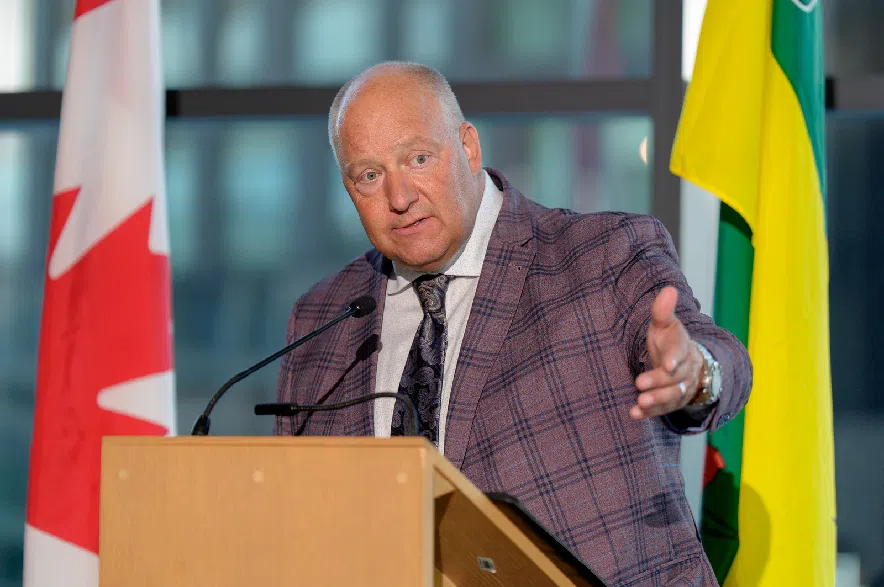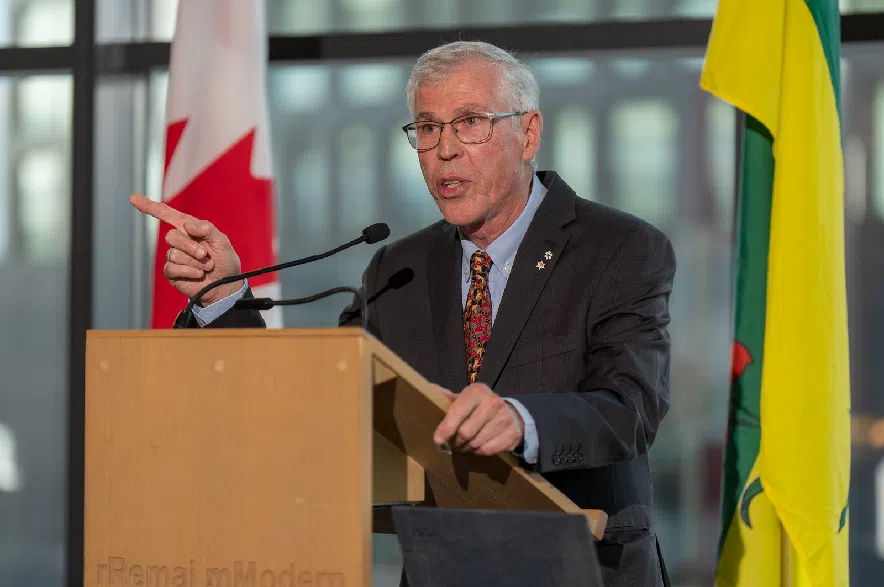This week marks 120 years of Saskatchewan.
On Thursday, an event was held at Saskatoon’s Remai Modern gallery, with speakers from across the province sharing the history of Saskatchewan, its treaties and its economy, while also looking towards the province’s future.
Read more:
- Moe looking to fix and expand trade with China in imminent trade trip
- Songwriter wishes Saskatchewan a happy 120th birthday with music video
- Saskatchewan marks 120 years with lessons from its history
Historian Bill Waiser said Saskatchewan has seen significant changes over the last 120 years.
When the province was first created, Saskatchewan was carved out of the Northwest Territories, and the province, along with Alberta, were both established on Sept. 1, 1905.
“Saskatchewan’s dream at the time was to be a prairie powerhouse province based on agriculture,” Waiser said.
“Farming was everything.”

Lieutenant Governor Bernadette McIntyre during the event in Saskatoon marking Saskatchewan’s 120th birthday. (Steve Hiscock/Submitted)
Waiser said the geographic centre of Saskatchewan used to be north of Prince Albert, with wheat grown in the south for the international export market. Today, the north remains a vital part of Saskatchewan’s economy, with large uranium and forestry industries.
Saskatchewan was home to many Anglo-Canadians 120 years ago, and while people were welcomed from other countries, Waiser said there was resistance to becoming a multicultural province.
“There was no place 120 years ago for First Nations or Métis people; they were not regarded as part of Saskatchewan’s future,” Waiser said.
Waiser said the province’s economic formula worked well initially, because Saskatchewan was growing half of the wheat in Canada by the outbreak of the First World War.

Evan Bray, host of the Evan Bray Show on 650 CKOM and 980 CJME, speaking at the event in Saskatoon. (Steve Hiscock/Submitted)
“We are one of the fastest-growing provinces in the country. In fact, by the 1920s, we were the third most populous province,” he said.
“Everybody doesn’t think about Saskatchewan that way, but we seemed well on our way to greatness.”
He described the 1920s as “thriving” and “booming” for Saskatchewan. There was still resistance to diversity, he noted, with many starting to question whether continental European immigrants could still fit into the province.
Then came the Great Depression, which Waiser said hit Saskatchewan hard because of its reliance on wheat. He said the province diversified its economy coming out of the 1930s and the Second World War.
“Today, we have a much more diversified economy, (and) Saskatchewan exports to a greater number of countries than any other province,” he said.
On the cultural front, Waiser said diversity was accepted in the province and used as a model as time progressed.
“In the 1970s, we were still trying to come to terms with new immigrants and finding a place for them in Saskatchewan society, for accepting them,” Waiser said.
“Indigenous people were supposed to disappear a century ago, (but) in many ways they are our future.”
Saskatchewan today
Turning the page to Saskatchewan’s story today, Waiser said the province is being pulled in two directions.
While many people think of Saskatchewan as “grid roads, country elevators, wheat fields,” Waiser said the province is becoming more and more urban, with booming cities.
“Two out of three people in Saskatchewan live in urban centers, and of those that live in cities, two out of three live in either Saskatoon or Regina,” he said.
While the cities are growing, the historian said it’s coming at the expense of the countryside, and there are now bigger farms and machinery working to produce the agricultural products that are still a major part of the provincial economy.
Waiser said with a move towards more industrial agriculture there are challenges of distance and isolation — the same challenges settlers faced when they arrived in the region more than a century ago.
“It’s come back to be an issue today, because people have to travel great distances from rural Saskatchewan to get services,” he said.
Waiser said that Saskatchewan today must recognize that when thinking about its future and the place of Indigenous and immigrants from around the world that these people are no different from those a century ago in terms of what they wanted for themselves, their children and grandchildren.
“We need to learn from the past and not repeat the nastiness,” he said. “We have to embrace these people and move forward together.
“We’re all in this together.”











